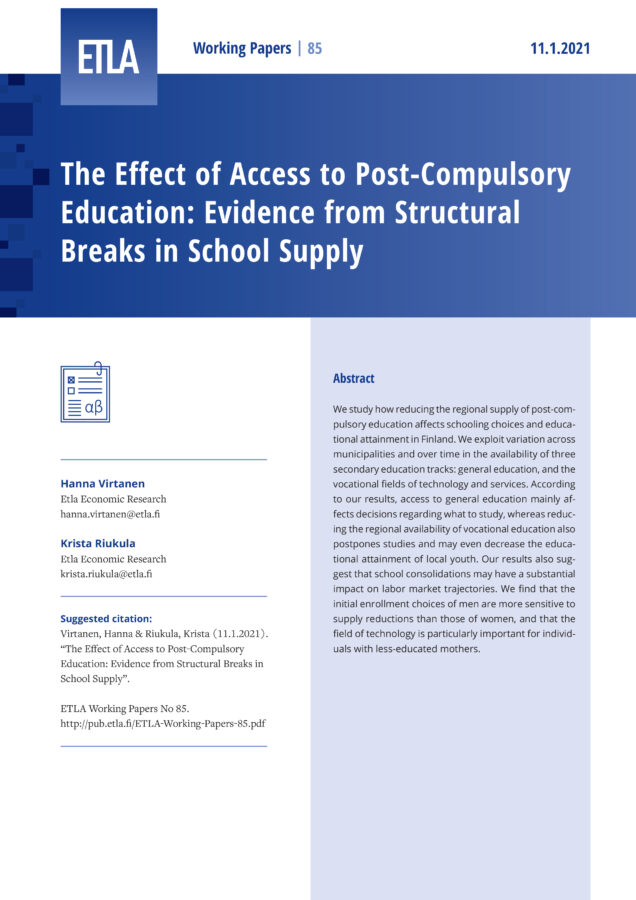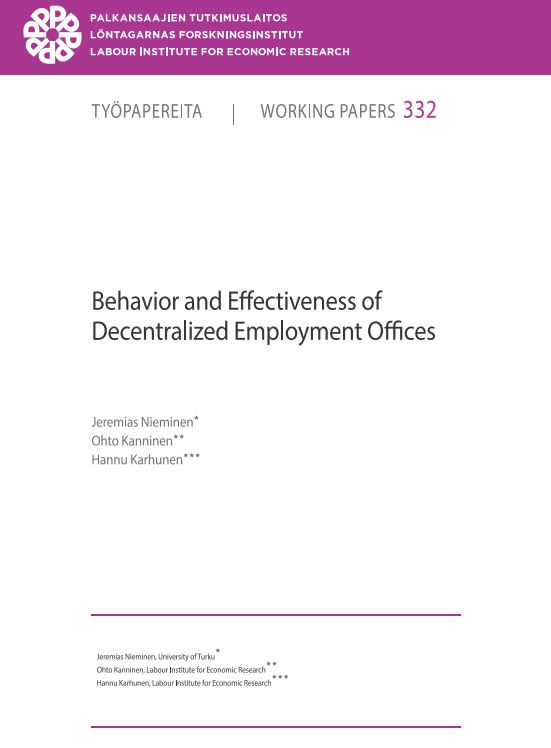How could independent Research Organizations contribute to the development of local jobs and skills agendas? Lessons from the Vantaa GSIP Project
TEXT | Gabriel Amitsis
This is the web-article No. 7 of the GSIP (Growth and Social Investments Pacts) Project, an initiative of the City of Vantaa (FI) to develop an innovative local jobs and skills agenda. It provides readers with on the ground information about the contribution of Finnish research community to the successful design and implementation of the Vantaa GSIP Project.
The evolving links between the research community and the local government are becoming a major focus of European regional policies in specific areas, as the role of municipalities in local development expands. Evidence-based research contributes to a renewed understanding of complex social needs and risks at the regional / local level, generate a range of complementary externalities between research findings and policy decisions and become thus a major determinant of the efficiency of regional and local innovation systems.
It is therefore obvious why the City of Vantaa decided to include two prestigious Finnish independent Research Organizations (the Research Institute of the Finnish Economy “ETLA” and the Labour Institute for Economic Research PT) as partners in the UIA funded Growth and Social Investments Pacts (GSIP) Project, one of the main instruments to promote an innovative local jobs and skills agenda by increasing capacity and skills of the workforce, providing favourable preconditions for business development and creation of jobs, based on distinctive local specificities. After almost three years of the GSIP Project implementation, it is now time to discuss the role of these Research Organizations in the fulfillment of its objectives and identify their contribution to the smooth development of a sound local jobs and skills agenda in the Vantaa area (it should be noted that the City of Vantaa forms part of the metropolitan area of the Helsinki capital and is one of the 26 municipalities within the Helsinki-Uusimaa Region, the most “innovative” Region in the EU, European Commission, Regional Innovation Scoreboard 2018, 2019, p. 16).
1. A brief snapshot of the GSIP Project
The GSIP Project reflects the City of Vantaa key policy decision:
- to promote growth and competitiveness of local companies;
- to improve level of education of workforce and offer better training possibilities for low-skilled employees, employees with outdated skills and unemployed persons through the design and implementation of a new, innovative and exceptional service and incentive model (Growth and Social Investments Pacts – GSIPs).
GSIPs are defined as a new instrument for municipalities to reach the maximum impact on public investments, subsidies and services (including training and vocational education) offered to local companies. GSIPs gather information and expertise about jobs and skills from different national, regional and local institutions and support interested local companies to take in a productive way advantage of them. To increase interest, companies’ employees are offered short free training programmes (partly in class), which deal with different topics on future employment demands (the content is based on previous surveys and interviews).
The GSIPs are tailored for Vantaa based companies employing 10-200 people, particularly companies involved in human intensive and routinely operated industrial sectors and IT-companies which have workforce of outdated skills caused by rapid changes in technologies and future business. They focus on three interrelated policy priorities:
- Recruitment of unemployed persons with low skills and education – The GSIP 1 model
- Training of existing staff – The GSIP 2 model
- Use of digitalization processes in the business routine – The GSIP 3 model.
2. The participation of the Finnish research community in the GSIP Project
The GSIP Project Partnership includes the City of Vantaa (acting as the Main Urban Authority) and representatives of the following sectors:
- the academia (the Metropolia University of Applied Sciences and the Laurea University of Applied Sciences);
- the research community (the Research Institute of the Finnish Economy “ETLA” and the Labour Institute for Economic Research PT);
- the market (ISS Services Ltd, Infocare Ltd, Solteq Plc., Finnair Cargo Ltd);
- the local government (Vantti Ltd).
A. The Research Institute of the Finnish Economy “ETLA” (https://www.etla.fi/en/) is an independent, private, non-profit economic research institute. It conducts applied economic research on key issues for Finnish business and the national economy, focused on key research priorities:
a) Impacts of Economic Policy – the aim is to provide information on how economic policy can promote competition and business conditions between companies in Finland and improve the competitiveness of Finnish production on the world market;
b) Impact of Driving Forces (Megatrends) – the research focuses on the driving forces’ (megatrend’s) effects on the business sector and on the preconditions of economic policies.
Results of ETLA projects are published as books or research reports, articles aimed at academic journals in the Working Papers series and short topical reports in the Policy Briefs series. The Institute completes 10–15 major research projects and a dozen policy briefs annually. It collaborates extensively with other domestic and foreign research institutes and universities, also with researchers in other fields than economics.

ETLA’s personnel comprise over 40 employees, most of the institute’s research staff have completed a doctorate degree in economics. Researchers lend their expertise to various committees and working groups set up by government departments and other public agencies, appear in hearings at parliamentary committees, and give presentations in scientific conferences and other events.
B. The Labour Institute for Economic Research (Palkansaajien Tutkimuslaitos – PT) is an independent and non-profit research organization founded in 1971 (https://labour.fi/en). The history of PT dates back to 1951, when the People’s Market Research Institute (Kansan Markkinatutkimuslaitos – KAMALA) was established. This was the first research institute of the Finnish labour movement. The task of the institute was to study consumption and living costs, agricultural subsidies, cyclical fluctuations in the economy and especially the development of economic competition.

The Institute’s current Finnish name, Palkansaajien Tutkimuslaitos, was adopted in 1993, when all Finnish central trade union confederations became members of its support association.
PT conducts independent and applied economic research that meets international quality criteria for science. Research priorities focus on labour economics, including education research, public finances and macroeconomics. The analysis of the Finnish labour market plays a key role in PT activities, particularly through the design and implementation of empirical projects relevant to wage earners through use of micro/individual-level data. Relevant research findings can be applied in political decision-making. In addition to producing high-quality research, key aim is to provide solution-oriented research and to interact with those who utilize this information.
PT labour market and education research covers a range of critical themes: wage formation; employment and unemployment; structural changes in the labour market; gender equality in the labour market; labour market flexibility, employment relations; occupational wellbeing, working conditions and health; education and training systems; migration; taxation and social security.
3. The contribution of ETLA and PT to the GSIP Project
The role of ETLA and PT in the design and implementation of the GSIP Project was elaborated through online discussions during September – October 2021 with Hanna Virtanen, ETLA Chief Research Scientist and Hannu Karhunen, PT Research Coordinator. Both experts confirmed the strong cooperation agendas between the City of Vantaa and the two research partners, and highlighted key issues about the exploitation of independent applied research for the development of sound local jobs and skills agendas.


DISCUSSION POINT No. 1: Why has your organization decided to participate as a key Partner in the Vantaa GSIP Project?
RESEARCH PARTNERS RESPONSE: ‘The project provided an interesting opportunity to do research on an important and policy relevant topic. The ability of local economies to meet the challenges created by occupational restructuring and technological development will be critical for their future success. Despite the massive importance of the topic, we still know very little about the effective ways to provide incentives and tools for firms to participate in the process of enhancing the local labour market.
The aim of the GSIP- Vantaa project was set to explore innovative ways to solve these issues and a crucial component of the project was to increase our understanding of what works. We as research-oriented bodies were very motivated to take part in these efforts.
Our goal was to ensure that the impact evaluation was carried out according to research standards. It was important to us that the findings of the project would be based on robust and coherent methods that would produce reliable results. The research design sketched in the project plan was promising and, it convinced us that providing reliable information could be feasible.
There are a lot of money allocated via the types of EU projects such as the GSIP Vantaa. Our task was to empirically examine what is the impact of the new GSIP service models on firms and on individuals. We consider this information to be very important to justify the usage of these funds. Moreover, these projects typically encourage dissemination of the solutions developed in them. It is very important to have reliable information on the impact before the new solutions are adapted into wider use. We took a participation in the project as an opportunity to apply well established research methods and standards to the impact evaluation with the aim of reaching reliable results and well-grounded conclusions.
Without researchers’ involvement the accomplishments and results of the project would likely have been exaggerated and thus, it almost appears to us that besides an important role as providing reliable information on the impact of the project, researchers have a critical role in keeping other partners in check: by reminding them about the limitations of causal inference’.
DISCUSSION POINT No. 2: Which tasks has your organization agreed to undertake?
RESEARCH PARTNERS RESPONSE: ‘Our main task was to undertake the impact evaluation. Furthermore, we developed a theoretical framework that describes potential mechanisms and avenues for incentives. The framework has been utilized in the planning of the project services as well as in collecting information. Finally, we have been commenting and providing support for team members at different stages of the project’.
DISCUSSION POINT No. 3: What activities in relation to the Project Working Packages has your organization completed during the period November 2018 – September 2021?
RESEARCH PARTNERS RESPONSE: ‘The project is coming towards an end. We have been working hard on collecting and analyzing data, as well as on drafting final report. However, the impact evaluation cannot be finalized before all project services have been completed. Moreover, before finishing the analysis, we still need to collect the final rounds of data and wait for registry data to become available. To provide a comprehensive view on the impact of the project, the evaluation must be one of the last activities of the project’.
DISCUSSION POINT No. 4: What is your overall perception from the Project implementation so far?
RESEARCH PARTNERS RESPONSE: ‘It has been a very impressive collaboration. The project has benefited from very motivated and talented individuals from several different backgrounds. However, it has been challenging to incorporate a research design and methods into a more practical EU project. Firstly, research resources in these types of projects are not in the level they are in more research-oriented projects. Moreover, since research is not the main focus of the project, not everything is planned merely thinking of its requirements.
This project has been first and foremost an important learning experience of incorporating research into these types of projects. It will hopefully also represent a starting point for something new, e.g. a new way of thinking and doing things, and collaborations of agents not typically working together before. Furthermore, we hope that we researchers in the project have taught something about what sort of things one needs to consider when talking about impact or drawing conclusions. We have certainly learnt a lot ourselves about how to design an experiment and what type of obstacles and difficulties there may be’.
DISCUSSION POINT No. 5: Have you identified any risk / challenge concerning the design and delivery of research services during the Project implementation? How did you address them?
RESEARCH PARTNERS RESPONSE: ‘It may be difficult to other project partners to remember and fully appreciate the importance of following the research design. Hence, it has been important for us researcher to be involved in the project in every step. Moreover, we have attempted to use all possible opportunities to explain and discuss the reasoning behind the research design and why it is important for the reliability of the results. This has improved the commitment of the other project partners in the aspects important for research.
Furthermore, there are several challenges regarding the research. Most of these challenges are there by design. Some of these challenges, such as an issue with statistical power, should have been considered already when planning the project, and were impossible to be dealt with anymore during the project. Some other, such as the planned timeline of the project and the restrictions in the availability of data, we have attempted to overcome by creating alternative performance measures based on alternative data sources. Moreover, the research activities have been given an extension period due to these difficulties’.
DISCUSSION POINT No. 6: Has the COVID-19 pandemic any serious impact on the delivery of research services during the Project implementation? How did you manage to address them?
RESEARCH PARTNERS RESPONSE: ‘Not a lot. Partners offering the services to the target group were obviously more severely affected. For research, the impact was mostly via participation rate and attitudes in the survey.
Related to COVID-19, it is important to note that the research design where firms are allocated randomly to the treatment and to the control groups is a prudent evaluation method even in these circumstances. The pandemic (and all other macrotrends) affects both groups equally, and thus, unexpected events like covid do not bias the evaluation results. If there would not be a control group for the program participants, then it would be extremely difficult to separate possible program effects from the other macro level trends’.
DISCUSSION POINT No. 7: Have you developed any best practice concerning the design and delivery of research services during the Project implementation?
RESEARCH PARTNERS RESPONSE: ‘It is very important that researchers are involved already in the planning of the project if there is a goal to measure the impacts of the project empirically. It is impossible to attain a proper research design without researchers in depth involvement. There are at least three key issues, that should be considered seriously in the further projects plans, or possibly when EU officials are evaluating project proposals in the coming funding rounds.
First, the research design where firms (or individuals) are allocated to the treatment and control groups, should not be proposed without actual power calculations (calculations related to statistical power). Practically, there need to be enough firms or individuals in the project region for this kind of evaluation to work. Local agents might not even know how many firms there are in their region when they are applying for the funding.
Second, impact evaluation requires data on baseline measures as well as on outcomes. Local agents may not have a full knowledge on any potential limitations in data availability or what data requirements are imposed by the research. It is crucial to have data collection and management plan as early as possible (in the application phase).
Third, researchers need to be prepared to educate local agents. If all parties do not follow the rules, then the reliability of project the evaluation can be at risk. Luckily, we managed to keep good contact with our project partners, and this was not an issue in our project.
To summarize, it is possible to add one key ingredient – the impact evaluation – into practical EU projects. It would be wise for the financers (EU), to incorporate impact evaluations more broadly to those programs that are not yet prudently evaluated. If a separate pre-plan (including data management plan) for the impact analysis would become a required part of the funding application, then there would be an increase in increase collaboration and learning between of local actors, research institutes and universities’.
DISCUSSION POINT No. 8: How did you disseminate the results of relevant research inside and outside the Project?
RESEARCH PARTNERS RESPONSE: ‘The project results will be available only after the treatment end, the data is available and analyzed. Therefore, it has not been possible to disseminate the results beforehand. Moreover, that type of information during the project might endanger the research design. We did not want our evaluation to impact the behavior of the agents.
However, we have had discussions during the project process with stakeholders and discussed the urgency of the topic, explained the design, and described the goals and principles of the project in several popular publications’.
DISCUSSION POINT No. 9: Do you believe in principle that local policy leaders across Europe should involve research organizations in the formulation of local jobs and skills agendas?
RESEARCH PARTNERS RESPONSE: The aim of research organizations is to provide information for policy makers. In this case research institutes can aid policy to promote and improve competitiveness, productivity and efficiency in local labor market. Research based policy making benefits the society’.
and a final policy quote from both Partners leadership.
”The economic policy – at both national and regional level – should be based on scientific research and acknowledge the importance of business sector success as the precondition of the well-being. Research organizations can help to promote growth and competitiveness of local companies which can lead to efficiency in local labor market as well”, Managing Director Aki Kangasharju, Research Institute of the Finnish Economy “ETLA”
“Improving adults’ skills and employment is a major challenge for the policy makers in Europe. We need to find cost-effective solutions and research institutes can help in this job”, Director Mika Maliranta, Labour Institute for Economic Research
This article was first published in: https://uia-initiative.eu/en/news/how-could-independent-research-organizations-contribute-development-local-jobs-and-skills


